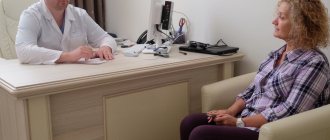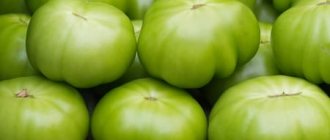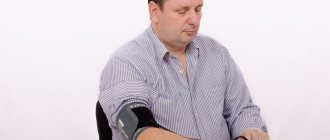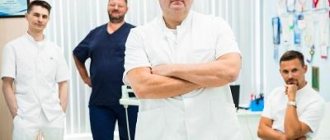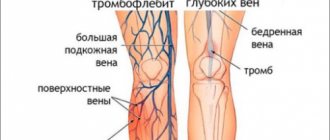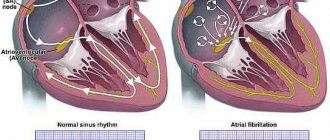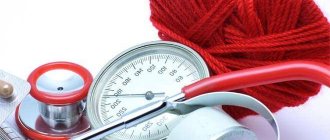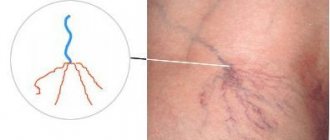What are varicose veins?
Varicose veins are a very common disease among the population over the age of 30, the essence of which is inflammation of the walls of the veins, their bulging, the appearance of nodules and, in severe cases, ulcers.
This is what varicose veins look like!
Most often, varicose veins of the legs present surprises to women who suffer, suffering not only from aesthetic defects, but also from the discomfort and pain that accompany varicose veins on the legs.
Varicose veins - causes
There are only a few main causes of the disease:
- Sedentary work or work that requires constant standing
- Obesity
- Heredity
- Age and gender. The greatest likelihood of developing varicose veins in women is 30-40 years old.
Phlebologists who treat varicose veins and Wikipedia claim that in a healthy person, blood flows through the veins from bottom to top. This is ensured thanks to:
- Rhythmic contractions of the heart
- The presence of valves in the veins
- Working the leg muscles
High static loads or reduced physical activity cause an increase in venous pressure in the lower extremities. The vessels cannot withstand such tension and begin to stretch, and their walls become thinner. This leads to the appearance of a gap between the valve and the vessel, the blood flow goes in the opposite direction, which is called reflux.
Varicose veins on the legs - symptoms and treatment
Taking into account modern treatment methods, the prognosis for varicose veins is favorable. Even in the most seemingly advanced cases, the elimination of varicose veins leads to a rapid improvement in the patient’s condition [8] [11].
However, when planning treatment, it is very important to assess its risks, since any intervention still carries potential adverse events. The direct responsibility of the doctor is to reduce their likelihood as much as possible. Before any manipulation, it is necessary to discuss with the patient all points regarding the intervention and obtain his signature on informed consent.
All adverse events can be divided into risks associated with surgery, including anesthesia, and risks on the part of the patient.
The risks of the operation may be small, for example, inflammation (phlebitis) in “welded” or sclerotic veins, accompanied by compaction in their projection and moderate pain. Areas of skin with reduced sensitivity and hyperpigmentation of the skin may appear. All these phenomena are temporary and, as a rule, pass quickly enough without any consequences [1].
Major complications include deep vein thrombosis, allergic and toxic reactions to anesthetic drugs. They are extremely rare, but for an individual patient who experiences such a complication, the case is 100 percent, even with statistics of 1 case per 10,000 operations.
Prevention of venous thrombosis is primarily based on calculating its risk using the so-called scoring system using the Caprini table. It contains various risk factors that have their own gradation. Taking into account each factor and obtaining a total score determines the degree of risk and, accordingly, its prevention. The main means of preventing venous thromboembolic complications are as follows:
- minimizing the trauma of the operation;
- early activation of the patient;
- compression jersey;
- pharmacological prevention, i.e., prescription of anticoagulants according to indications - blood thinning drugs (low molecular weight heparins or direct oral anticoagulants) [10].
Allergic and toxic reactions to the drug are, unfortunately, very difficult to predict. Testing for allergies to certain drugs does not prevent its occurrence and is not used in world practice. Therefore, it is extremely important to be prepared for the occurrence of these complications in any patient and to be able to provide immediate assistance. For this purpose, special equipment (first aid kits) with all necessary medications are always available in the operating room.
Risks from patients are usually associated with concomitant pathologies, for example, hypertension, coronary heart disease, epilepsy, etc. To prevent attacks of such diseases, a thorough medical history is taken and consultations with specialists are scheduled, who “give the go-ahead” for the operation.
As for the prevention of varicose veins, it simply does not exist, since the main cause of the pathology is still not clear, which could be influenced and thus prevent the occurrence of the disease. This is also associated with fairly frequent relapses of varicose veins after any type of intervention. However, given all the advantages of minimally invasive treatment, this is not a significant problem. Keeping your legs in order is quite simple, the main thing is to contact a phlebologist in time[3][5][6][10].
Varicose veins: symptoms and stages of the disease
The clinic of varicose veins is determined by the stages of the disease:
- Stage 0. The first symptoms are heaviness and fatigue in the legs after a working day, swelling of the ankles, feet and lower legs in the late afternoon. In this case, all symptoms disappear after a night's rest or after active walking.
- Stage 1. Symptoms of stage 0 include spider veins on the legs, pain along the veins and rare night cramps in the calves.
- Stage 2. At this stage, veins and nodules can already be felt on the skin, which appear after a long sitting or standing position. Already at this stage, the likelihood of blood clots is high.
- Stage 3. In addition to all the above symptoms, there is constant swelling in the late afternoon, which may not go away completely in the morning.
- Stage 4. The skin on your legs may become dark in color. Skin atrophy appears.
- Stage 5. Trophic ulcers appear that are capable of healing.
- Stage 6. Trophic ulcers do not heal.
Varicose veins: complications you should know.
If you postpone treatment until later, you can soon wait for complications to appear.
Blood clots due to congestion can lead to thrombophlebitis, edema, pulmonary infarction, or even sudden death from thromboembolism. Non-healing trophic ulcers, eczema and dermatitis may appear, and the color of the affected skin may change. Constant swelling leads to compaction of fatty tissue. A very unpleasant complication is bleeding from varicose veins, which occurs due to thinning of the skin at the site of an enlarged vein or mechanical damage.
Bleeding from the veins of the lower extremities
At the same time, women may have varicose veins of the pelvis, which manifests itself as pain after sex and walking, dysmenorrhea, severe PMS, discharge, etc.
Homemade recipes against varicose veins
There are many home methods for treating varicose veins of the lower extremities. Let's look at the most popular ones.
Decoctions
- From dried blueberries. The decoction is prepared in the proportion of 1 tbsp. dried berries per glass of boiling water. You need to drink 150 ml of liquid twice a day.
- From cypress. To prepare a decoction, add 2 tablespoons of leaves and bark of the plant to 1 liter of boiling water, simmer on the stove for 10 minutes. After cooling, strain, take the solution 7 tablespoons per day.
- From hazel leaves. Brew a glass of crushed plant with a liter of water, boil for an hour. Take the decoction 0.5 cups twice a day.
- Made from honey and nutmeg. The decoction is prepared in the proportion of a glass of ground spice to 1 liter of boiling water and 5 tbsp. honey Combine all components, boil, cool. Take a glass of the drink 2 times a day - an hour before meals in the morning, 2 hours after meals in the evening.
Tinctures
- From the fruit of horse chestnut. Place the peel and kernels of the plant in a three-liter jar so that it fills half the container. Pour 1.5 liters of vodka over the horse chestnut. Store the tincture in a dark place for a month. It needs to be stirred three times a week. After 30 days, take a tablespoon of infusion before each meal. The course of treatment is 14 days.
- From lilac leaves. It is necessary to fill a liter jar halfway with the plant, fill it to the top with vodka, and leave for 7 days. When the solution is ready, take it twice a day, one tablespoon at a time.
- From white acacia flowers. Pour 100 g of plant inflorescences with 0.5 liters of vodka and leave for 14 days. The resulting tincture should be generously wiped over the affected area.
Ointments
- Made with carrots, apple cider vinegar and aloe vera. Combine the grated vegetable with the plant in a 1:1 ratio, stir thoroughly, add a couple of drops of apple cider vinegar. Apply to the problem area before bed.
- From calendula. Grind several flowers of the plant, combine with a teaspoon of boiled water. Mix with 20 ml of your regular moisturizer. Apply to affected area twice daily.
- From curdled milk. Wipe the affected area with sour milk twice a day.
Compresses
- From aloe vera. It is necessary to cut the leaf of the plant lengthwise and apply it to the damaged area.
- From fresh burdock leaf. Rinse the plant with warm water and apply it to the leg with sore veins overnight. Secure with a gauze bandage.
- From fresh potatoes. Cut the root vegetable into circles, apply to the affected area overnight, secure with a bandage. In addition to potatoes, you can use tomatoes in the same way.
- Made from garlic, orange pulp, honey and olive oil. Combine all components in equal parts in a container, close it and leave for 12 hours. Then apply it to the affected area as a compress.
- From apple cider vinegar. The acid must be diluted with water in a 1:1 ratio. Soak gauze or cloth in liquid, apply to the problem area, leave for 20 minutes, then rinse with clean water.
- From cabbage leaves. They must be applied to the affected area at night, secured with gauze or a cloth bandage.
Therapeutic baths
- With added clay. Place your feet in a basin of warm water, adding a glass of red clay. Gently stir the powder - this way you will simultaneously take a foot bath and do foot exercises. The optimal duration of the procedure is 30 minutes.
- With the addition of marsh dried grass. Prepare a decoction at the rate of 100 g of plant per 1 liter of water. Cool it, pour it into a basin, lower your legs there. The procedure lasts 30-40 minutes.
- With the addition of tincture of willow and oak bark. The composition can be purchased at a pharmacy or prepared independently by infusing a glass of dried plants per liter of vodka. Then it should be added to foot baths at the rate of 50g per 1 liter of water.
- With the addition of pine buds and vinegar. Boil a liter of water, add 2 tbsp. plants and 1 tbsp. vinegar. Pour the broth into a basin, dilute to a comfortable temperature, lower your feet, take a bath for 15-20 minutes.
Varicose veins: diagnosis
Diagnosis of this disease is carried out by a phlebologist during examination, he determines the presumptive stage of the disease and prescribes functional tests and instrumental research methods:
- Ultrasound Dopplerography
- Ultrasound duplex angioscanning
- Radionuclide and radiopaque phleboscintigraphy
- Phlebomanometry. Allows you to determine the condition of deep veins.
- Plethysmography
- Photoplethysmography
YES. Fedorov diagnoses varicose veins
After passing the diagnosis, the phlebologist makes a verdict and prescribes the most rational treatment for a particular case.
Varicose veins: treatment
Defeat varicose veins. Treatment in Moscow.
How to carry out treatment? Initial varicose veins (Moscow has great opportunities in this area) can be cured in three ways: compression therapy, physical therapy and drug treatment. Varicose veins (laser treatment in Moscow has become very common recently) are treated until complete recovery. Radiofrequency ablation (RFA) treatment has also become popular. All these methods of treating varicose veins can be found on the pages of our website. In short:
Varicose veins Treatment is surgery!
Surgical intervention implies a radical solution to the problem.
- Phlebectomy is the surgical removal (pulling out with a special metal probe) of the affected areas of the veins, which eliminates reflux and varicose veins.
- Varicose veins Laser treatment in Moscow. The technique is also aimed at eliminating vertical reflux and cauterizing blood vessels from the inside to stop growing varicose veins. Laser treatment (you can read the reviews yourself on our website) is very effective. Varicose veins, laser treatment, and its price are of interest to many patients.
- Varicose veins Radiofrequency treatment is the most modern way to get rid of the disease. Varicose veins and RFA treatment in Moscow are inseparable concepts. The procedure is carried out using a special radiofrequency device by cauterizing the vein wall with microwaves. Varicose veins disappear so quickly. RFO treatment has become a salvation for many who do not want to perform a traumatic classic phlebectomy.
Doctors Semenov A.Yu. and Kalachev I.I. conduct a master class on the treatment of varicose veins using RFA
Each of these methods has its own specific indications and contraindications, which should be taken into account by the phlebologist and surgeon. Varicose veins, RFO treatment in Moscow has become a question for many patients. Many people are interested in laser treatment, the price of which sometimes varies greatly between clinics. In our clinic, laser treatment of varicose veins, when cost is as important as quality of life, is quick and painless! And then varicose veins (after surgery there is no need for rehabilitation at all) will stop tormenting you for many years.
Ointment for varicose veins
Many patients go for help to a pharmacy that sells drugs against varicose veins for external use. Varicose veins are insidious, how best to treat and with what means? Here are some of them:
- Venoruton gel - contains rutin, which improves vascular tone and reduces swelling.
- Aescin gel is a drug based on horse chestnut extract and heparin, reduces the possibility of blood clots, relieves swelling and tones the veins.
- Ginkor Gel - created on the basis of the ginkgo biloba plant, eliminates swelling, increases the tone of veins and relieves inflammatory processes.
- Heparin ointment - eliminates the formation of blood clots and relieves pain.
But it is better not to be deceived by expecting immediate removal of varicose veins; you need to seek help from qualified specialists who will remove varicose veins. Treatment (the price for health cannot be high) will prevail.
Magic discs for getting rid of varicose veins “no varicose veins method” and “personal phlebologist”.
Phlebologists have broken many copies exposing this method of “legally” taking money from the population. Let's look at some aspects of advertising. The sites advertising this “product” do not provide any information about the mechanisms of action of these courses. In fact, these are a set of simple exercises for varicose veins that help relieve swelling and heaviness in the legs. These exercises can be easily found on the Internet without paying a penny. It is quite natural that these complexes cannot reduce the diameter of varicose veins, but they can allow them to receive a tidy sum from patients. Any guarantee can easily be negated by a defense of non-compliance. And the amount is not so large that all buyers rush to demand a refund. There is no method for varicose veins - there are varicose veins, but there is no money.
Conclusion: Fooling naive people
How to treat varicose veins using traditional methods
You can “tame down” varicose veins (treatment with folk remedies has not yet died out) with recipes that are passed down from generation to generation. Varicose veins: treatment with traditional methods. Popular means:
Homemade recipes with good reviews:
- Compress of grated garlic with butter (1:2);
- A compress made from wormwood pulp mixed with sour milk;
Varicose veins: how to treat pain
- Nettle infusion for internal use;
- Tincture of chestnut flowers in alcohol for internal use, etc.
Possible consequences
Folk remedies for varicose veins are far from harmless. These are concentrated extracts from plants that have strong side effects when taken orally. This especially applies to people with diseases of the stomach and pancreas. Herbs affect the acidity of gastric juice. Therefore, their use can cause exacerbation of chronic diseases of the digestive system.
It is necessary to monitor allergic manifestations (skin itching, rashes, swelling). If such symptoms occur, discontinue further use.
To use traditional methods, you need faith in the remedy and patience. Few people pay attention to the recommendation to walk in thin cotton socks through the grass dew at dawn and not take them off until your feet are dry. This charming recipe brings out the best in nature.
Varicose veins: prevention
To prevent the development of varicose veins it is necessary:
- Watch your weight.
- Do not wear shoes with very high heels and tight claws or stockings.
- Lead an active lifestyle and do daily exercises.
- Wear compression hosiery against varicose veins.
- Self-massage your feet.
- Do contrasting foot washes.
- Avoid prolonged exposure to sunlight.
- Do not overuse hot baths and saunas.
- Sleep with a bolster under your feet.
- At the first symptoms of the disease, consult a doctor.
By following these recommendations, you will be protected from varicose veins, although there is still a chance of development, since the hereditary factor is a predetermining factor. Look, read and analyze everything that you found on our website in the section: varicose veins treatment (reviews, photos, results).
Prevention of varicose veins is the best way to combat varicose veins!
In conclusion, we can say that varicose veins are a disease that can be successfully treated without surgery using endovascular and compression therapy, but for this it is necessary to see a doctor in the first stages, when the symptoms are still mild and the matter has not reached complications. Modern medicine has stepped forward and at the moment there are excellent methods of endovascular treatment of this disease - fast, painless and effective. Following the doctor's orders, following all instructions and refusing to self-medicate will give excellent results in treatment.
Varicose veins of the lower extremities - prevention
For prevention, it is necessary first of all to adhere to the work regime. You cannot constantly be on your feet or sit in one position. From time to time it is worth taking short breaks to give your legs a rest.
After a hard day at work, you can massage your feet, after which it is advisable to put your feet on a raised platform. This improves blood flow from the extremities.
Exercises to improve venous blood flow in the legs
Don't get carried away with hot baths and saunas. To prevent varicose veins, it is much more useful to take a contrast shower and rinse your legs with cool water.
It is important to monitor your weight. Excess body weight increases the load on the venous system and contributes to the development of the disease.
If there is a predisposition to developing the disease, and it is not possible to eliminate all risk factors, it is better to engage in prevention. Even if the disease has already begun, do not despair. Varicose veins of the lower extremities are not a death sentence. By detecting the problem in a timely manner and contacting specialists, you can get rid of the disease and avoid serious complications.
We invite you to visit our specialist phlebologist and get rid of varicose veins in the early stages.
Frequently asked questions about varicose veins from our patients on the Internet
What is the best treatment for varicose veins?
Today, the best treatment for varicose veins is a comprehensive approach, including modern endovascular intervention on the venous system, compression therapy and drug therapy.
Why do varicose veins form on the legs?
The venous vessels of the lower extremities experience the greatest hydrostatic load, both during static and dynamic loads. By the way, varicose veins practically do not occur in other mammals. To some extent, varicose veins are a person’s price for walking upright.
Why do varicose veins of the lower extremities develop?
Varicose veins of the lower extremities develop due to the following factors:
- Heredity.
- Increased load on the lower limbs, especially static ones.
- Obesity.
- Age.
- Gender, women are at greater risk of developing varicose veins.
Can varicose veins be cured without seeing a doctor?
Varicose veins cannot be cured without the participation of a doctor. Moreover, for adequate treatment it is necessary to contact a specialized specialist, a phlebologist. Only if this condition is met will you receive the expected result of treatment of varicose veins.
Varicose veins of the lower extremities - how to treat with ointments
In the pharmacy you can find a huge number of ointments for varicose veins of the lower extremities. They are based on substances that improve tissue trophism, relieve swelling and strengthen the vascular wall. Varicose veins of the lower extremities, photos and reviews of ointments are available on the drug pages on the Internet.
Treatment of varicose veins with ointments and gels
In the early stages of the development of the disease, the use of various ointments can improve the condition of the venous system and slow down the progression of the disease, but it will not be possible to completely defeat varicose veins of the lower extremities. The results will be available only after visiting a doctor.

